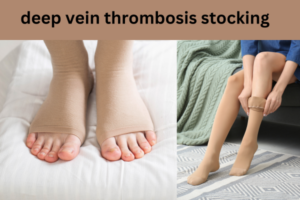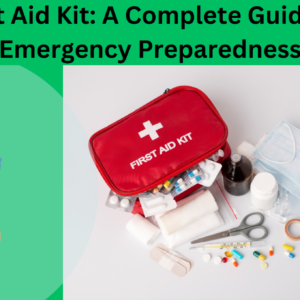The Importance of DVT Stockings in the Nursing Profession: A Life-Saving Tool
Overview
Blood clots in deep veins, usually in the legs, are a significant medical disorder known as deep vein thrombosis (DVT). It can result in potentially fatal side effects like pulmonary embolism if left untreated. DVT stockings, sometimes referred to as compression stockings, are an essential tool in the toolbox of nurses who play a vital role in managing and preventing DVT.
This blog explores the advantages of DVT stockings, their significance in nursing, and how they improve patient outcomes.
What Are Stockings for DVT?
Specially made compression clothing, known as DVT stockings, continuously presses on the legs. This pressure lowers the chance of clot formation, improves blood circulation, and stops pooling. To satisfy particular medical demands, they are available in a variety of kinds and compression levels.

What Makes DVT Stockings Essential for Nurses?
1. Avoiding Thrombosis in Deep Veins
Preventing blood clots in patients who are immobile or recovering from surgery is one of the main purposes of DVT stockings. Nurses frequently provide care for patients who are at a high risk of DVT, such as those recuperating from surgery or bedridden. By ensuring that blood flow continues unhindered, compression stockings lower the risk of clots.
2. Assisting with Recovery Following Surgery
Due to their restricted movement, postoperative patients are especially susceptible to DVT. By increasing circulation, decreasing edema, and minimizing the chance of complications, DVT stockings aid in the healing process.
3. Improving Comfort for Patients
DVT stockings reduce pain from venous insufficiency or edema in addition to preventing clots. By including these stockings in care plans, nurses may greatly increase patient comfort and satisfaction.
The Operation of Graduated Compression Technology in DVT Stockings
The pressure that DVT stockings apply is greatest at the ankle and progressively lessens as it moves up the leg. By simulating natural circulation, its design promotes venous return to the heart and lessens venous stasis.
Lowering Venous Pressure
DVT stockings successfully minimize the risk of clots by preventing blood from collecting in the lower limbs by supporting vein walls and lowering vein distension.
Enhancing the Flow of Oxygen
Improved circulation speeds up healing and averts problems like ulcers or skin deterioration by supplying oxygen-rich blood to tissues.
The following are the main advantages of using DVT stockings in nursing: 1. Better patient outcomes
It has been clinically demonstrated that DVT stockings lower the risk of blood clots. By using them, nurses can help their patients recover more quickly and with fewer difficulties.
2. Economical Prevention
It is significantly less expensive to prevent DVT with stockings than to treat consequences like pulmonary embolism. They are therefore a sensible option for patients as well as healthcare professionals.
3. Adaptable Use
DVT stockings are appropriate for a range of patients, such as those who are pregnant, have post-operative demands, or have chronic illnesses. They are reliable for a variety of care situations for nurses.
DVT Stocking Use Difficulties
1. Concerns about Compliance
Stockings can be difficult or painful for patients to wear for long periods of time. Patients must be informed by nurses about their significance and appropriate use.
2. Improper Fit Stockings that don’t fit properly can be less effective. For best results, nurses must make sure patients receive the appropriate size and compression level.
3. Insufficient Knowledge
Many patients and even medical professionals are ignorant of the role DVT stockings play in preventing clots, despite their demonstrated advantages. Nurses can promote increased use and awareness.
How Nurses Can Encourage the Use of DVT Stockings
1. Teaching Patients
Describe the dangers of DVT and how compression stockings help to reduce them. Demonstrations and visual aids can improve comprehension.
2. Observation and Assistance
Verify the comfort, fit, and presence of any issues in patients wearing DVT stockings on a regular basis. Provide assistance to resolve problems as soon as possible.
3. Including Stockings in Procedures
In order to establish DVT stockings as a routine component of treatment regimens for patients who are at risk, nurses can collaborate with healthcare teams.
Success Stories from Real Life
Regular usage of compression stockings has been linked to a decrease in DVT incidence in certain institutions. For example, a study conducted at a tertiary care hospital revealed that including stockings in the treatment plan reduced DVT incidence by 30%. These illustrations highlight how crucial it is to use this straightforward yet powerful tool.
In conclusion
For many patients, DVT stockings represent a lifeline, not just a medical accessory. These stockings are an essential tool for nurses to help patients recover more quickly, avoid major problems, and provide higher-quality care overall. The nursing profession may carry on its tradition of providing patients with creative, efficient, and compassionate care by adopting the usage of DVT stockings.
FAQ 1. What is the purpose of DVT stockings?
By enhancing circulation and decreasing venous stasis in the legs, DVT stockings help avoid blood clots.
2. Is it painful to wear DVT stockings?
Most patients rapidly get used to them, though some may find them tight at first. In order to guarantee comfort, proper size is essential.
3. How do nurses choose a patient’s appropriate stockings?
In order to determine the proper compression level and fit, nurses evaluate the patient’s condition, risk factors, and measurements.
4. Can DVT stockings take the place of other precautions?
Despite their effectiveness, DVT stockings are most helpful when used in combination with other preventive measures, including hydration and mobility exercises.
5. How frequently should one wear DVT stockings?
The length of time is determined by the patient’s condition and the advice of the healthcare professional. Patients are advised by nurses on appropriate clothing schedules.






Reviews
There are no reviews yet.